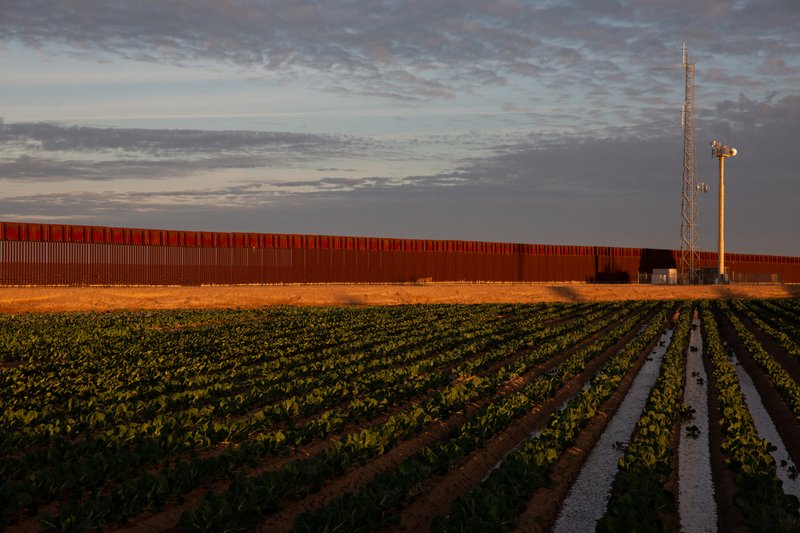DURANGO, Mexico -- For decades, U.S. farmers, landscapers and builders tapped a seemingly endless supply of cheap labor: the waves of illegal immigrants coming across the southern border. The workers arrived in time for harvests and construction booms. They did the low-wage manual labor that Americans were unwilling to do.
By the 2000s, more than half of American farm workers were undocumented, according to the Labor Department. But now -- thanks to border enforcement, the surging cost of smugglers and changes in migration patterns -- the number of people crossing into the United States illegally is nearing the lowest level since the early 2000s. There are more Mexicans leaving the United States than arriving there.
For the White House, that might be a triumph. But for the agriculture industry, the effect is acute. Each year, its labor force dwindles.
To fill those positions, employers have turned to temporary visa programs that recruit workers in Mexico and Central America. Since 2016, the number of U.S. agricultural visas has grown from 165,000 to 242,000, a record high, according to the Labor Department. Amid an intractable debate over immigration and border security, America's labor force is quietly being transformed, as many employers see no choice but to shift from illegal to legal labor.
Visa recruiters are now driving into remote villages in Mexico, broadcasting their hiring sprees on portable radios, loudspeakers and Facebook ads. In rural America, farmers are converting hotels into dormitories for visiting Mexican apple-pickers.
Despite his claim that immigrants take jobs away from Americans, President Donald Trump has touted the guest worker program, acknowledging the difficulty in finding American manual laborers and pledging to make it easier for farmers to hire workers legally.
The country's temporary foreign worker program includes a category for nonagricultural jobs, known as H-2B visas. Despite a huge demand from industries that are also struggling to replace undocumented workers -- such as shrimping and hospitality -- H-2B visas are capped annually at 66,000.
This year, employers applied for 97,800 nonagricultural visas in the first five minutes of the visa lottery, far more than ever before, crashing the Labor Department's website, the department said in a news release.
There is no such limit for workers on agricultural visas, and U.S. employers apply to bring in workers for up to 10 months per year on unskilled visas for agriculture, known as H-2A visas.
"Without them there would be no broccoli or lettuce," said Tony Tew, an area manager for Foothill Packing, a labor contractor in Yuma, Ariz. "They want to come here to work, and they work hard."
There is perhaps no better example of the confluence of border security and America's labor supply than Yuma, known as the "Winter Salad Bowl" of the United States, where lettuce and broccoli are grown a few miles from the border fence. Before the government increased its enforcement -- with fencing, additional agents and harsher jail sentences -- farmers there once relied on a steady stream of illegal workers. But this harvest season, there are an estimated 3,800 H-2A workers in the city, almost all from Mexico, up from 2,858 in 2016, according to Yuma officials.
Some of them, like Humberto Ruiz Silva, live in northern Mexico and wake early each morning to cross the border into Arizona, flashing his visa to the U.S. immigration agent.
"The money is triple for me, and for some others more than 10 times what they would make in Mexico," Silva, 39, said.
In rural Mexico, temporary visas have always been enormously coveted, and the surge in demand for legal workers is already remaking entire towns. Last year, the average hourly wage for an H-2A worker was $12.01 per hour, exponentially more than Mexico's $5-per-day minimum wage, according to the Center for Immigration Studies, which analyzed Bureau of Labor Statistics wage data.
Around 4,000 of the H-2A workers now come from El Mezquital in Durango state, according to the Center for Immigration Studies, which recruits there. One of Mexico's poorest regions, it has been mostly forgotten by the federal government, where for years men have picked apples in local orchards for less than a dollar an hour. Guillermo Mathus, the center's president, has created a pipeline between that region and the fields of Washington state.
When he returned to El Mezquital on a trip last month, residents stopped him everywhere he went to ask about the program.
"Are you hiring women yet?" a young woman asked.
"When can we submit our applications?" a young man asked.
Across El Mezquital, homes and trucks have been bought with American salaries. Many workers have begun saving for the children's university fees. On their refrigerators, some workers keep magnets from the places they've worked: harvesting hops in Idaho, cherries in Oregon, apples in Washington.
Before U.S. employers apply for temporary work visas, they must prove that they can't find Americans to do those jobs, posting advertisements in local newspapers, for example. They must arrange interviews for their workers at crowded American consulates in Mexico. They must pay the "prevailing wage," which is typically a few dollars per hour higher than minimum wage.
Temporary work visa programs are heavily regulated, requiring employers to provide standard housing for workers and compensation for those injured on the job, for example. Some farmers say the system is too difficult and expensive to navigate.
"Basically, we pretty much gave up," said Don Hartman, a vegetable farmer in Deming, N.M. Instead of hiring laborers with the H-2A program to replace undocumented workers, he now tries to make do with the legal workers he has used for years. "They need to make [the program] less cumbersome, less regulated, less political. Those people want to come and work and go back home and we need the help. Why can't they make a single program that will work for both of us?"
Business on 02/22/2019
